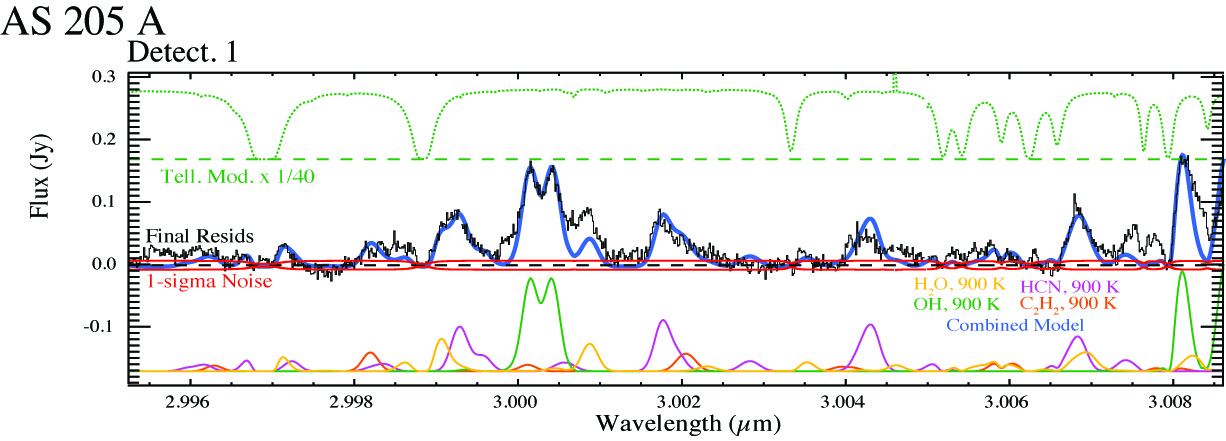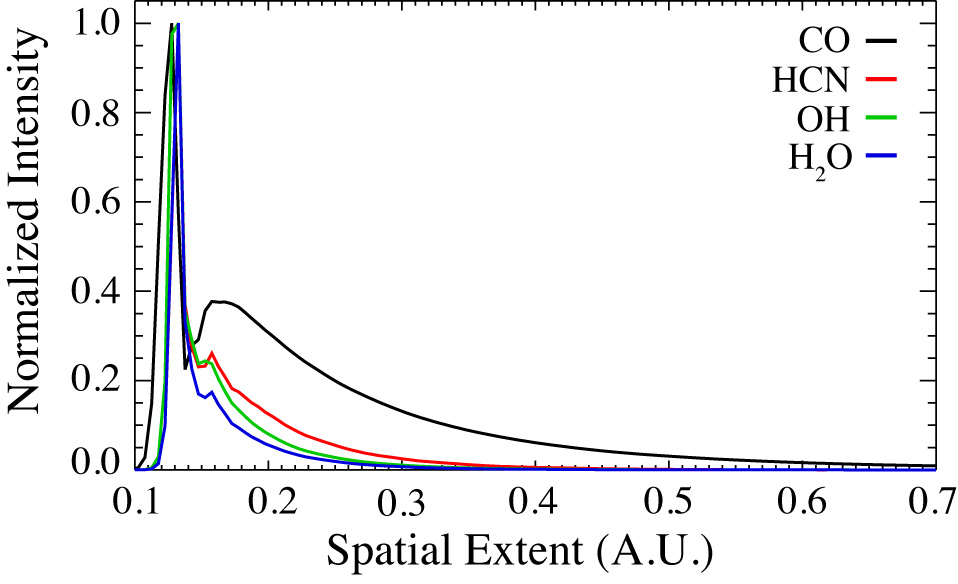Dr. Avi M. Mandell

Observations of Young Gas-rich Protoplanetary Disks
By improving our knowledge of the characteristics of the gaseous component of protoplanetary disks, we can improve our understanding of the origin and evolution of planetary systems. Observations and models of extra-solar planets and protoplanetary disks demonstrate that the final characteristics of a planetary system depend sensitively on factors directly associated with the thick gaseous nebula that forms the bulk of the mass during the early stages of star and planet formation: disk structure, dust dynamics and composition, and dynamical interactions with the gas disk such as planet migration and orbital eccentricity enhancement.
My research focuses on infrared observations of warm molecular gas emission from the planet-forming region of circumstellar disks, with the goal of constraining the temperature and composition of proto-planetary material during the initial stages of planet formation. By combining advanced data reduction algorithms with accurate modeling of the terrestrial atmospheric spectrum and a novel double-differencing data analysis technique, we have achieved very high-contrast measurements (S/N ~ 2000) of molecular emission from disk around bright nearby stars using state-of-the-art spectrographs such as NIRSPEC on the Keck telescope and CRIRES at ESO's Very Large Telescope facility (Paranal, Chile).
By testing the temperature and composition of the protoplanetary disk in the region where planets are forming, these measurements will provide critical data for further improving planet formation models, and will lay the groundwork for observations over a wider range of temperature and density, for more molecules, with the next generation of ultra-sensitive high-resolution NIR imagers and spectrographs such as the NIRCam and NIRSpec instruments on the James Webb Space Telescope.
First Detection of Near-Infrared Line Emission From Organics in
Young Circumstellar Disks (2012)
In disks around low-mass stars, we achieved the first detections of emission from HCN and C2H2 in circumstellar disks at near-infrared wavelengths from several bright T Tauri stars using the CRIRES spectrograph on the Very Large Telescope and NIRSPEC spectrograph on the Keck Telescope. We spectrally resolved the line shape, showing that the emission has both a Keplerian and non-Keplerian component as observed previously for CO emission. We used a simplified single-temperature local thermal equilibrium (LTE) slab model with a Gaussian line profile to make line identifications and determine a best-fit temperature and initial abundance ratios, and we then compared these values with constraints derived from a detailed disk radiative transfer model assuming LTE excitation but utilizing a realistic temperature and density structure. Abundance ratios from both sets of models are consistent with each other and consistent with expected values from theoretical chemical models, and analysis of the line shapes suggests that the molecular emission originates from within a narrow region in the inner disk (R < 1 AU).

Mandell et al. 2012, Figure 2: VLT-CRIRES data for AS 205 A overplotted with model spectra of LTE molecular emission from a simple slab model convolved with a Gaussian line shape. Emission from H2O, OH, and HCN is clearly detected; emission features from C2H2 are also detected but the lines are weaker and blending with other features makes the detection less secure.

Mandell et al. 2012, Figure 11: Distributions of the four primary molecules derived from disk modeling with RADLite. All of the molecules emit primarily from within 0.2 AU, and only CO has emission extending out to 0.5 AU.
Discovery of OH in Circumstellar Disks Around Young
Intermediate-Mass Stars (2008)
We detected emission from multiple low-excitation rovibrational transitions of OH from the two Herbig Ae stars AB Aurigae and MWC 758 in the 3.0-3.7 μm wavelength range (L band), using the NIRSPEC instrument on Keck II. The inner radius for the emitting region in both stars is close to 1 AU. We compare an optically thin LTE model and a thin-wedge fluorescence model, finding rotational temperatures of 650-800 K and OH abundances of 1042-1045 molecules for the two stars. Comparisons with current chemical models support the fluorescence excitation model for AB Aurigae and possibly MWC 758, but further observations and detailed modeling are necessary to improve constraints on OH emission in different disk environments. Our current sample suggests correlations in temperature and abundance with disk mass that may signal grain growth (i.e. planetesimal formation) and/or water vapor depletion.

Mandell et al. 2008, Figure 1: Examples of line detections for both stars. The top traces show the stellar spectrum with terrestrial lines, as measured (black). A synthetic atmospheric spectrum is overlaid for comparison (green). The very bottom traces show individual residuals for the science target (blue) and the comparison star (black). The middle trace shows the difference of the science and comparison star residuals (blue) bounded by 3σ photon-noise uncertainty limits (red). Individual residuals (bottom) are multiplied by a factor of 10, their difference (middle) by a factor of 50.

Mandell et al. 2008, Figure 3: Predictions of a thin wedge fluorescence model for AB Aurigae. For a specific absorbing column density, a lower-state rotational temperature (Tlow) and wedge thickness (H/R) are derived to match the observed component-averaged fluxes for each transition; the Δχ2 value (compared to the minimum value of 1.52) and standard confidence intervals for the fit are also shown.
Relevant Publications
Mandell, A. M., Bast, J., van Dishoeck, E. F., Blake, G. A., Salyk, C., Mumma M. J., & Villanueva, G. "First Detection of Near-infrared Line Emission from Organics in Young Circumstellar Disks". 2012, ApJ, 747, 92
Mandell, A. M., Mumma, M. J., Blake, G. A., Bonev, B. P., Villanueva, G. L., & Salyk, C. "Discovery of OH in Circumstellar Disks around Young Intermediate-Mass Stars". 2008, ApJ, 681, L25

Contact Information
NASA GSFC
Code 693.0
Greenbelt, MD 20771
Email: Avi.Mandell (at) nasa.gov


